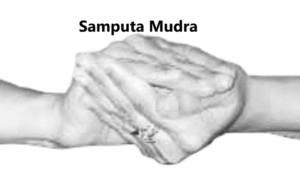Samputa Mudra
Introduction
Mudras are yogic hand gestures that regulate prana (life energy), impacting physical, mental, and spiritual well-being. Samputa Mudra is a sealing or containment mudra, used to contain and harmonize internal energy, enhance concentration, and protect subtle energies during meditation or spiritual practices.
The term “Samputa” in Sanskrit means “box, container, or sealed vessel,” signifying this mudra’s ability to hold and stabilize energy within the practitioner. It is commonly used in meditation, pranayama, and energy-focused practices to cultivate inner focus and mental clarity.
Meaning
Samputa = Container, sealed vessel.
Mudra = Yogic seal or gesture.
Purpose: To contain prana, stabilize internal energy, enhance focus, and protect subtle energies during meditation or spiritual practice.
How to Perform (Practice)
Sit comfortably in a meditation posture such as Sukhasana, Padmasana, or Vajrasana.
Relax shoulders, spine, and arms.
Cup hands with left underneath right, create a hollow space between palm; hold hands in front of torso.
Close your eyes and focus on containing prana, stabilizing energy, and enhancing inner awareness.
Maintain the mudra for 5–15 minutes, gradually increasing as comfort improves.
Tip: Keep hands relaxed; avoid tension in fingers, wrists, or shoulders.
Benefits
Physical Benefits
Stabilizes energy flow in the hands, arms, and chest.
Improves circulation and pranic distribution.
Enhances overall vitality and internal balance.
Mental & Emotional Benefits
Increases concentration, focus, and mental clarity.
Reduces anxiety, stress, and mental distractions.
Promotes emotional stability and inner calm.
Spiritual Benefits
Helps contain and protect subtle energies during meditation.
Supports mindfulness and introspection.
Enhances spiritual concentration, inner harmony, and energy integration.
Contraindications
Finger, hand, or wrist injuries.
Shoulder or upper arm discomfort should practice under supervision.
Avoid over-practice if hands, wrists, or shoulders feel strained.
Anatomy & Physiology
Musculoskeletal: Engages intrinsic hand muscles and stabilizes fingers; light forearm activation.
Circulatory system: Improves localized blood flow in hands and forearms.
Nervous system: Activates sensory nerves, promoting mental focus and calmness.
Endocrine system: Supports subtle energy centers associated with concentration and inner balance.
Kinesiology
Fingers interlocked to form a sealed and stable structure, directing energy inward.
Thumbs aligned to reinforce the energy “seal.”
Shoulders relaxed; wrists neutral.
Enhances hand stability, proprioception, and subtle energy containment.
Neurology
Stimulates peripheral nerve endings, enhancing mind-body integration and concentration.
Promotes parasympathetic activity, reducing mental distraction and stress.
Supports cortical regions associated with focus, emotional regulation, and awareness.
Enhances subtle energy perception and containment during meditation.
Duration of Mudra
Beginners: 5 minutes.
Intermediate: 10–15 minutes.
Advanced: 20–30 minutes during meditation or pranayama.
Tip: Regular practice helps contain and harmonize internal energy, improving concentration and meditation depth.
Counter Mudra
Gyan Mudra: To enhance knowledge and mental clarity while containing energy.
Prana Mudra: To energize the body after practice.
Apana Mudra: To release excess or stagnant energy before using Samputa Mudra.
Conclusion
Samputa Mudra is a meditative mudra that contains and stabilizes internal energy, enhances concentration, mental clarity, and inner harmony, and supports spiritual practices. Regular practice integrates physical, mental, and energetic benefits, making it ideal for meditation, pranayama, and yogic energy work.
FAQ
Q1. Can beginners practice this mudra?
Yes, it is safe for all levels with gentle practice.
Q2. Can it help with mental distraction or lack of focus?
Yes, it promotes concentration, calmness, and energy containment.
Q3. How long should it be practiced daily?
5–15 minutes for beginners; up to 30 minutes for advanced practitioners.
Q4. Can it be combined with meditation or pranayama?
Yes, it enhances meditation and pranayama by stabilizing prana and mental focus.
References
Swami Satyananda Saraswati, Asana, Pranayama, Mudra, Bandha.
B.K.S. Iyengar, Light on Yoga.
Hatha Yoga Pradipika – Mudras for energy stabilization and meditation.
Gheranda Samhita – Mudras for mental focus and pranic control.
Kuvalayananda, Yoga Mimamsa Journal.

